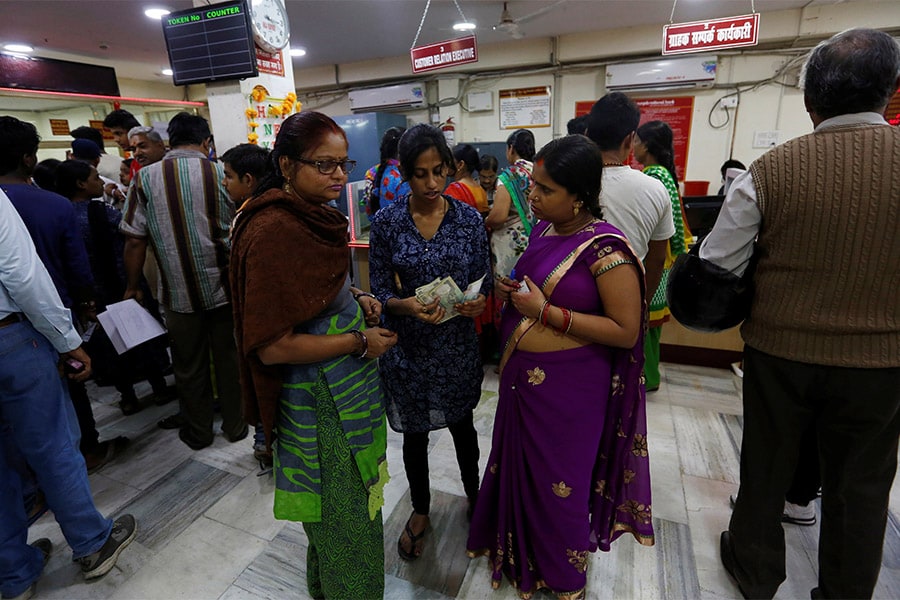
Bank Q4 earnings: spotlight to stay on levels of loan growth, NPAs
Sequential quarterly growth for banks expected to be weak; vehicle-finance NBFCs to show improved growth

(Image:REUTERS/Adnan Abidi.The image is for illustrative purposes only.)
India’s banks will brace themselves for another tough quarter (January to March 2017), as weak loan growth and no clear resolution to the stubborn problem of high levels of non-performing assets amongst both state-owned and private banks. Credit growth for the industry continues to the tepid as banks remain risk averse, due to high levels of stressed assets and still subdued business activity. Due to the lag effect of demonetisation late last year, banks will continue to see a rise in deposit growth.
The Q4FY17 quarter will see some of the heavyweights such as HDFC Bank, IndusInd Bank and Yes Bank in coming days.
The Q4FY17 quarter will see some of the heavyweights such as HDFC Bank, IndusInd Bank and Yes Bank in coming days.
Sequential earnings growth from state-owned banks is expected to be weak for the March-ended quarter, due to lower trading revenues and higher provisioning towards bad loans. But on an year ago basis, the earnings numbers are likely to read better, due to the base effect of Q3FY16, when all banks were impacted by the Reserve Bank of India’s (RBI) asset quality review.
“The RBI AQR in FY16 led to high NPAs, and due to weak recoveries till date, provision levels are likely to remain elevated (ageing of NPAs),” say Alpesh Mehta and Shubham Banka, analysts at Motilal Oswal Financial Services.
Asset quality will, thus, continue to be the most spoken about for the last financial quarter of 2016-17. One could expect heavyweights such as State Bank of India, ICICI Bank and Axis Bank to continue in their effort to clean up their balance sheets. The commentary and the resolution of NPAs from the top management at all these banks will be closely watched.
The RBI, in its last policy statement on April 7, had urged banks to deal with the issue of NPAs themselves. “Creeping forbearance in the treatment of bank losses is untenable and costly for the rest of the economy,” the RBI governor Urjit Patel had told the media, after the monetary policy statement.
The RBI, in its last policy statement on April 7, had urged banks to deal with the issue of NPAs themselves. “Creeping forbearance in the treatment of bank losses is untenable and costly for the rest of the economy,” the RBI governor Urjit Patel had told the media, after the monetary policy statement.
It has last week issued new guidelines to resolve the bad loans problems. The RBI has said that: “A bank will be placed under PCA framework based on the audited annual financial results and the supervisory assessment made by RBI.” All banks in India will now be monitored on the matrix of capital, asset quality and profitability and divided on the basis of three levels of “risk thresholds.”
“We expect pressure on asset quality to continue due to factors such as: expected resolution in the steel sector is delayed; some large accounts may be recognized as NPAs, and the lag impact of demonetisation results in slippages from small value accounts,” the Motilal Oswal analysts said.
“We expect pressure on asset quality to continue due to factors such as: expected resolution in the steel sector is delayed; some large accounts may be recognized as NPAs, and the lag impact of demonetisation results in slippages from small value accounts,” the Motilal Oswal analysts said.
“We factor net slippage ratio of 2.5 percent (2.4 percent in 3QFY17) and provision-to-operating profits of 82 percent (79 percent in 3QFY17) for state-owned banks and 33 percent (37 percent in 3QFY17) for private sector banks,” they added in the report to clients.
Last week, DCB Bank reported a weak set of numbers, where net profit slid 24 percent to Rs 52.86 crore and gross non-performing assets rose. So while asset quality will remain a real concern, fund managers and research analysts will watch for the commentary relating to the resolutions on stressed assets.
“Some of the concerns in the sector persist. Credit growth will continue be slow,” says Dhananjay Sinha, head of institutional equities of Emkay Global Financial Services, who added that large and small companies continue to face contraction in their businesses.
Last week, DCB Bank reported a weak set of numbers, where net profit slid 24 percent to Rs 52.86 crore and gross non-performing assets rose. So while asset quality will remain a real concern, fund managers and research analysts will watch for the commentary relating to the resolutions on stressed assets.
“Some of the concerns in the sector persist. Credit growth will continue be slow,” says Dhananjay Sinha, head of institutional equities of Emkay Global Financial Services, who added that large and small companies continue to face contraction in their businesses.
The non-banking financial companies (NBFCs) segment are expected to see a divergent set of earnings data. Select NBFCs could witness improved growth, particularly those in the retail or vehicle loans space. But those lending to pure small and medium enterprises (SMEs) could see slower growth, says Sinha from Emkay Global.
“In a seasonally-strong quarter, vehicle finance (VF) NBFCs are expected to report sequentially better earnings, led by strong business growth and better recoveries,” say HDFC Securities’ analysts Darpin Shah, Vishal Rampuria and Pranav Gupta in a report to clients.
“In a seasonally-strong quarter, vehicle finance (VF) NBFCs are expected to report sequentially better earnings, led by strong business growth and better recoveries,” say HDFC Securities’ analysts Darpin Shah, Vishal Rampuria and Pranav Gupta in a report to clients.
In the case of SBI, investors will also look for any observations from the SBI management on the integration of five of its subsidiaries -- besides the Bharatiya Mahila Bank (BMB) -- with itself, from April 1 onward.
X





